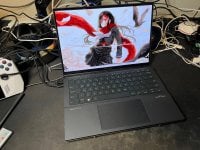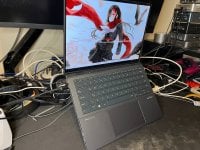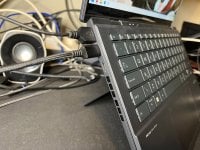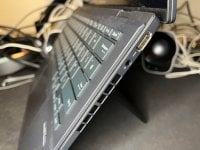Getting Up to Speed
If you've not been keeping in the loop with the newest Zenbook Duo, let me fill you in on the basics. This is ASUS' latest weird design featuring two full OLED panels, following after Lenovo's 2023 Yoga Book 9i, and iterating on their previous dual-screen system that included an ultrawide display above the keyboard. There are two models in the wild at the moment, with the key differentials being the CPU, screens, RAM, and storage, with the lower-end model packing Intel's Ultra 7 155H alongside two 60Hz 1200p OLED panels, 16GB of soldered DDR5 RAM, and a 1TB SSD. The model I have by comparison has Intel's Ultra 9 185H, two 120Hz 1800p screens, 32GB of soldered DDR5 RAM, and a 2TB SSD. That's a lot of specs, but you're sure as heck going to be paying for them, with the lower model clocking in at £1800, and the model I picked up going all the way to £2000. Since pre orders opened earlier this year (and were subsequently delivered) availability has been spotty, so you might find one model entirely unavailable for hefty stretches of time. When I ordered the Ultra 9 model the Ultra 7 model wasn't even an option, but now it seems to be the only one available; this'll naturally vary from region to region, so it's worth keeping an eye out if you are interested in one model over the other. There's not much in the way of upgradability on offer here though, so it's worth keeping in mind if you think the 16GB of RAM or 1TB SSD might be a limiting factor for what you plan to use the system for. Though you can technically upgrade the SSD later, it's buried quite deep into the laptop, so I wouldn't recommend it.
I will just explicitly state that I did buy this with my own money (and my wallet weeps for that decision) and that I probably won't be writing up a full review for it due to a few time constraints on my part. With that in mind though, I wanted to throw together something as thorough as I could after a week or so of use. It's a really cool system after all, it'd be a waste not to talk about it!
In terms of an unboxing experience, there isn't much to expect from ASUS. It's fine, it's premium, and you get a 65W USB C charger alongside a pressure-sensitive stylus pen. Much like with other ASUS systems I've covered, it's a bit of a shame to see two-part charging plugs still being used when a 65W GaN plug and separate cable is a much neater solution. I haven't even unwrapped ASUS' charger in favor of the plug I got with the AYANEO 2 last year, paired with a 2m UGREEN USB C to USB C cable. If there's a reason why more companies aren't opting for smaller plugs I'd surely like to hear it.
The laptop itself is a sleek package. You get a really discrete ASUS "A" etched into the lid, fitting well into the larger ZenBook aesthetic. Lifting the screen for the first time (no issues doing this with one finger if that's something you use as a metric for a good laptop) you'd be forgiven for thinking this is just a normal (if slightly thick) laptop. The screen looks great, the keyboard feels really solid with some really nice travel to the keys, and the trackpad is an absolute joy. There is of course more. To reveal the second display, all you need to do is pull the keyboard away from the bottom half of the system. Though it is pretty securely held in place with two magnetic feet on the bottom, it's really easy to lift it from the top, bringing the true potential of the system to life.
More Than Just Two Screens
Having two screens in such a compact package is a genuine game-changer, and I say this as somebody who owns two very decent portable gaming monitors (and a pen display that I will continue to advocate for as a portable monitor). What I'm still not quite used to is just how seamless it all is. The keyboard connects to the laptop using one of pogo pins or Bluetooth depending on whether it's mounted or being used externally. You're guided through connecting it via Bluetooth for the first time as a part of the Windows setup, with this allowing the keyboard to automatically transition for you when removed. The screens keep it similarly simple, with the delay in the second display activating being pretty much on par with what you'd expect from any HDMI cable being plugged in. It just works, and I can't complain at that.
I have found it a little stressful having an OLED laptop for the first time though, and I don't think I'm quite over that hurdle yet. On one hand the screens look fantastic. The colours are vibrant (coverage including 100% sRGB, 94% of AdobeRGB, and 100% of P3 according to my Spyder dongle) and the blacks are, well, black. These are OLED displays after all. They're great monitors, but as both a light mode enjoyer and a person who frequently leaves one monitor aside for messaging services and emails, I'm naturally concerned about burn in. I'm taking what small steps I'm aware of to mitigate this, like turning down the brightness of whichever display I've deemed secondary and static, but I would be interested to hear from people who have actively been using OLED laptops for their thoughts. I did consider that that a 16:10 display could be the ideal for OLED systems, with 16:9 content that you might get from games and media putting black bars where your most frequent static icons would be: the taskbar and the top of your windows. It's difficult to say how they'll hold up over time, but I'm trying my best to find a balance between using the displays at their best, and them lasting as long as they possibly can.
Beyond the two screens and really quite great keyboard we have some surprisingly good IO, with the Zenbook Duo sporting two Thunderbolt 4-enabled USB C ports, one USB A port, a full-sized HDMI port, and a 3.5mm headphone jack. It might not sound like a lot, especially if you've been following my recent spur of Mini PC reviews, but when you factor in the form factor of this thing, you can really color me impressed. If I had to give it a slight nitpick, it's that I really would've preferred there to be a USB C port on both the left and right side of the body to give you more options when it comes to charging. As things stand both USB C ports live on the left side; it's fine, but it's one of those things that you might get caught out on if your charging cable is on the short side.
The real standout of the laptop for me hasn't actually been the screens or the keyboard. They've both been great and I've obviously not been let down by them, but the kickstand has really shown its value so far. I want more laptops to have kickstands, even if the keyboard doesn't detach. Much like how I praised the Z13 Flow tablet, a kickstand is great for just allowing the laptop to take up less room. It's been great for me even leaving the keyboard mounted to the system when working, bringing the top display closer to eye level and letting me have a podcast or something on YouTube throughout my day. To say the stand is sturdy would be an understatement too. It shows no weakness even when holding the laptop by the stand alone. A little more movement could be appreciated, with it capping out at 90 degrees, but I will say that's more than enough for the vast majority of use cases. It holds its position well, and I even managed to use it on my lap with two screens, which was a marvellously weird feeling.
My First Ultra Series CPU
When it came to performance I wasn't quite sure what to expect. Intel's new Ultra line of CPUs are a bit of a mystery to me, serving as a less power-hungry companion to the more familiar 14th Generation iNumber counterparts. The Ultra 9 on show here clearly is a strong chip, but I have read that it's being held back by the body it finds itself in. That does make sense though, there's only so much cooling you can throw into something like this, and there's only so much heat you can allow when you have a screen attached to the main heat-generating components. It's all a weird balancing act, and I'm not sure I can say how successful it's been.
I always forget that Mario Kart 8 had a full mini-map on the touch screen!
The synthetic benchmarks are solid. Running it through Geekbench 6 I got a multi-core score of 12456 and a single-core score of 2414. These are the second highest scores I've seen from my lineup of systems without discrete graphics, with it only being beaten out by Geekom's A7, itself packing a Ryzen 9 7940HS and a bit more room for cooling. When it comes to Cinebench 2024 performance drops a little, with the 517 multi-core being a good chunk away from the A7's score of 830. Single core stats were almost identical though, with the Ultra 9 managing 103. It's difficult to really find a fair point of comparison given what the Zenbook is cramming into its shell, it's not like I'm going to say you should just go buy the A7 because it performs better here. If performance were all you cared about, you wouldn't be looking at the Duo anyway. The numbers should at least give you something to work with though.
Onto gaming performance you'll find a relatively mixed bag. The Intel Arc graphics are really a new leap in terms of what an integrated GPU is capable of from Intel, and they've managed to carry me through what I've asked of the system. Monster Hunter Rise is something of a champion for integrated graphics, running well on just about anything I decide to throw it onto. What I would usually target is 1080p and low settings, but much to my surprise this system is capable of maintaining a solid 60fps at its native resolution, albeit again on low graphics. I didn't know Monster Hunter Rise could look so good on low settings! I'm obviously not making full use of this 120Hz panel, but it certainly would do a better job of pushing those higher framerates if I did bump the resolution back down. It should go without saying that your lighter games like Balatro will run with no issues too. I do plan on adding this system to my testing lineup if you are interested in exactly what it'll run over at the Integrated Graphics PC Gaming group. It's a bit light on content for now, but that's the place to check in for a more thorough look at gaming performance down the line when I have the time to play around more.
In terms of emulation I have unfortunately been held back a little by the Micro SD card holding my emulators deciding to break its own legs. In short it's now useless, and I'm left setting everything up again. Mario Kart 8 at least ran pretty well on Cemu, and I've of course had Ocarina of Time 3D playing well on Citra. One area of disappointment I will mention is that the touch screen doesn't appear to work properly with Cemu. Instead of a tap being an input, I instead need a small swipe. I've encountered similar things before with Windows' touch features, but usually disabling the hold for right click feature will fix it. That doesn't seem to be the case here. The touch screen does work fine for Citra, so if anybody has any ideas I'm all for hearing them. I would love to have it working properly to give me a fairly authentic experience playing games like Wind Waker HD. Those small interactions with the UI really do go a long way, especially when a solid stylus is included with the system.
It's Not Perfect
As much as I've enjoyed the Zenbook Duo so far, it really hasn't been without its frustrations. There are some aspects of it that really put me off recommending it as a whole, and that is a genuine shame to me. The core of these issues is that the on-battery performance is remarkably subpar. Turning on the system without it being plugged in will have your mouse stuttering as it moves across the desktop for the first few minutes, and you can forget trying to multitask. At best you can have a YouTube video playing on one screen and some static non-interactables like messages and emails on another. Going beyond that you'll really feel the sluggish nature of this system without power. I really can't fathom why it struggles so much; Crelanders's X15 can do better than this, and that thing is powered by a Celeron N5095! For the £2000 you're paying you should expect more, and you should realistically get more.
It's not as though the system doesn't have that power available to it, as evidenced by the actually-capable showing when plugged in. I'm hoping this will improve with software updates, but I'm not holding my breath. Beyond the performance though, some parts of the software are just not well thought-out, with the real crux of this being in the ScreenXpert application.
If you read my post back in January you might actually recall me praising this software as a natural iteration of what I'd become familiar with on the Zephyrus Duo. In a lot of ways it does improve on that too. You've got a bunch of useful settings like turning off the second screen, showing virtual inputs, and giving you stats on the keyboard while it's disconnected. On paper it's good software, but there's just too many small irritations. Chief among these for me is that there's just no clean place for it to live. On the Zephyrus Duo the second screen was just that: secondary. I had no issues a button being on the far left of this screen and it never really got in the way. Where should it live here though, on a system that's designed to have two identical screens, two primary displays in a sense? It would've made sense for it to be mapped to a key on the keyboard to make it show up. It'd surely be more useful than the emoji button that already has a very accessible keyboard mapping (Win+. If you've never used it before). Instead you either have to leave it on your screen in a static location, which is surely not great on an OLED panel, or you have to hide it altogether, summoning it only when you decide to open the ScreenXpert app via the start menu. Add to this the fact that it decides to completely revert saved settings every time it's closed and reopened, re-enabling things like the dynamic jellyfish wallpaper, and I just find myself having no reason to bother. It shouldn't be wrong for me to expect more from ASUS here, neither OLED devices or multi-screened devices are new to them; they actually champion both!
Though my ScreenXpert issues do feel somewhat minor, I really don't believe the on-battery performance is. As somebody who generally lives close to a plug, and will generally be limited to YouTube watching and review writing on the go, it's acceptable for me. I'm not as happy as I could be, but it still manages to fill the role I wanted it to. I can't confidently say it would for others. This is an absolutely stellar package that I hope I'll be using for the foreseeable future, but I'm interested to see what others think. Do unique form factors do enough to warrant their equally unique price tags, or should laptop manufacturers have their sights set solely on bang for buck? Let me know what you think.










